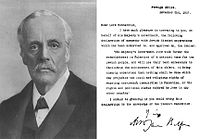- Declaration to the Seven
-
The Declaration to the Seven was a document written by Sir Henry McMahon and released by the British Government[1] in response to a memorandum issued anonymously by seven Syrian notables in Cairo who were members of the newly formed Party of Syrian Unity, which had been established in the wake of the Balfour Declaration of 1917 and the publication by the Bolsheviks of the secret Sykes-Picot Agreement.[2] The memorandum requested a "guarantee of the ultimate independence of Arabia". The Declaration stated the British policy that the future government of the regions of the Ottoman Empire occupied by Allied forces in World War I should be based on the consent of the governed.[3]
Significance of the Declaration
The Declaration to the Seven is notable as the first British pronouncement to the Arabs advancing the principle of national self-determination.[4] Although the British sought to secure their position by adopting that foremost Wilsonian doctrine, neither Britain nor France was prepared to implement their promises to the Arabs nor to abdicate the position won by victory over the Ottoman Empire.[5]
Although it was not a widely publicized document, the Declaration may explain the action of General Allenby in September 1918 after the Battle of Megiddo when (acting on instructions from London) he ordered a halt to the advance after the rout of Turkish forces outside Damascus in order to allow the city to be captured by Arab forces, thus bolstering the Arab claim to the independence of Syria whilst simultaneously undermining the French claims to the territory under the terms of the Sykes-Picot Agreement.[4]
See also
- Damascus Protocol
- Hussein-McMahon Correspondence
References
- ^ "Report of a Committee set up to consider certain correspondence between Sir Henry McMahon (his Majesty's high commissioner in Egypt) and the Sharif of Mecca in 1915 and 1916". His Majesty's Stationary Office. 1939-03-16. Archived from the original on 2008-06-18. http://web.archive.org/web/20080618062554/http://domino.un.org/unispal.nsf/3d14c9e5cdaa296d85256cbf005aa3eb/4c4f7515dc39195185256cf7006f878c!OpenDocument. Retrieved 2008-07-18.
- ^ Choueiri, Youssef M. (2000). Arab nationalism, a history: nation and state in the Arab world. Cambridge, MA: Blackwell Pub. pp. 149. ISBN 0-631-21729-0.
- ^ Friedman, Isaiah (2000). Palestine: A Twice-Promised Land? Vol. 1: The British, the Arabs, and Zionism, 1915-1920. New Brunswick, N.J., U.S.A: Transaction Publishers. pp. 195–197. ISBN 1-56000-391-X.
- ^ a b Paris, Timothy J. (2003). Britain, the Hashemites, and Arab Rule, 1920-1925: the Sherifian solution. London: Frank Cass. pp. 50. ISBN 0-7146-5451-5.
- ^ Holt, P. M.; Ann Katherine Swynford Lambton and Bernard Lewis (1977). The Cambridge history of Islam. Cambridge, Eng: University Press. pp. 392. ISBN 0-521-29135-6.
Key documents of Mandate Palestine 

1910s Damascus Protocol · McMahon–Hussein Correspondence · Sykes-Picot Agreement · Balfour Declaration of 1917 · Declaration to the Seven · Anglo-French Declaration · Faisal–Weizmann Agreement · King-Crane Commission Report1920s San Remo Resolution · Palin Commission Report · Franco-British Boundary Agreement (1920) · Haycraft Commission Report · Churchill White Paper · League of Nations Mandate · Palestine Order in Council · Franco-British Boundary Agreement (1923)1930s Shaw Commission Report · Hope Simpson Report · Passfield White Paper · MacDonald Letter · Peel Commission Report · Woodhead Commission Report · White Paper of 19391940s Bilmore Programme · Anglo-American Committee of Inquiry Report · Statement of Information Relating to Acts of Violence · United Nations Partition Plan for Palestine · Israeli Declaration of IndependenceHistory · Timeline · Aftermath Categories:- Historical documents
- World War I
- World War I documents
- British Empire
- Arab–Israeli conflict
- Israeli–Palestinian conflict
- History of Israel
- History of Islam
- Fertile Crescent
- Documents of the British Mandate for Palestine
Wikimedia Foundation. 2010.

